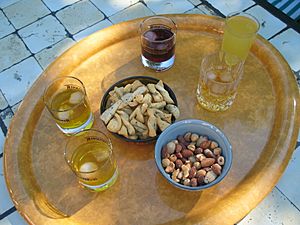Apéritif and digestif facts for kids
Apéritifs (pronounced ah-peh-ree-TEEFS) and digestifs (pronounced dee-jeh-STEEFS) are special drinks served around meal times. An apéritif is usually enjoyed before a meal to help you feel ready to eat. A digestif is typically served after a meal, often thought to help with digestion. These drinks are a part of many cultures around the world.
What is an Apéritif?
An apéritif is a drink usually served before a meal. Its main job is to get your appetite ready. These drinks are often dry, meaning they are not sweet. Some common choices include certain types of wine or other special drinks.
Sometimes, an apéritif is served with small snacks. These snacks might be crackers, cheese, small pastries, or olives. These little bites are called hors d'oeuvres or amuse-bouches.
The word apéritif comes from French. It comes from the Latin word aperire, which means "to open." In France, people sometimes use the shorter, more casual word apéro.
A Look Back in Time
People have been enjoying apéritifs for a very long time, possibly since the 400s!
In 1796, a person named Antonio Carpano in Turin, Italy, created a modern version of a drink called vermouth. This drink became very popular.
By the 1800s, apéritifs were common in Italy. They were served in popular cafes in cities like Turin, Rome, and Milan.
A special apéritif called Dubonnet was created in France in 1846. It was made by a chemist named Joseph Dubonnet. He wanted to find a way to make a bitter medicine taste better. He added herbs and spices, and it worked so well that the recipe is still a secret today! This drink became popular with soldiers in North Africa.
Apéritifs became very popular across Europe. By the early 1900s, they were also commonly served in the United States.
In Spain and some Latin American countries, apéritifs have been a part of their tapas tradition for hundreds of years. Tapas are small dishes served with drinks. This idea of serving food with drinks also became popular in Italy in the 1970s.
Types of Apéritifs
There isn't just one type of drink that is always an apéritif. Often, these drinks are dry rather than sweet.
- In France, the apéritif can be different depending on the region. For example, a drink called pastis is popular in the south. In other areas, people might drink Calvados (a type of brandy) or Champagne. A popular cocktail is Kir, made with blackcurrant liqueur and white wine. If Champagne is used instead of white wine, it's called a Kir Royal. Sometimes, a simple glass of red wine is also served with small snacks.
- In Italy, a drink called aperitivo is common. This can be vermouth or wine. Other popular choices include Martini, Aperol Spritz, and Campari with soda.
- In the Eastern Mediterranean, a drink called arak is served with small dishes called meze.
- In Britain and Ireland, traditional apéritifs include sherry and dry madeira.
What is a Digestif?
A digestif is a drink served after a meal. Many people believe it helps with digestion, though there isn't strong scientific proof for this. If it's served after coffee, it might be called a pousse-café. Digestifs are usually enjoyed by themselves, without ice or mixers.
Common types of digestifs include:
- Brandies: These are strong drinks made from distilled wine or fruit. Examples include Cognac and Armagnac.
- Fortified Wines: These are wines that have extra alcohol added to them. Sweet sherry, port, and madeira are examples.
- Liqueurs: These are sweet, flavored drinks. They can be bitter or sweet. Many liqueurs contain herbs, like amari or herbal liqueurs. Other examples include Drambuie, Amaretto, and Jägermeister.
- Other Distilled Drinks: These include drinks like ouzo or tequila.
- Cocktails: Some mixed drinks, like a Black Russian, can also be served as digestifs.
Bitter digestifs often contain special herbs. These herbs are thought to help calm the stomach.



